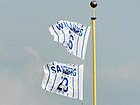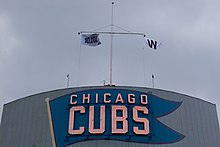| Revision as of 01:05, 29 September 2008 editBigHaz (talk | contribs)Administrators17,265 editsm →Detail: proofreading is your friend← Previous edit | Revision as of 01:27, 29 September 2008 edit undoPetero9 (talk | contribs)Extended confirmed users, Rollbackers894 edits →History: fixed bad part.Next edit → | ||
| (One intermediate revision by the same user not shown) | |||
| Line 1: | Line 1: | ||
| ]]] | ]]] | ||
| The '''Cubs Win flag''' is flown at ] after every ] ] victory.<ref name=CCWBF>{{cite web|url=http://www.cubworld.com/product/521/Chicago_Cubs_W_Banner_Flag__Cubs_Win_Cubs_Win.html|title=Chicago Cubs 'W' Banner Flag - Cubs Win! Cubs Win!|accessdate=2008-09-23|publisher=CubWorld.com}}</ref> The flag |
The '''Cubs Win flag''' is flown at ] after every ] ] victory.<ref name=CCWBF>{{cite web|url=http://www.cubworld.com/product/521/Chicago_Cubs_W_Banner_Flag__Cubs_Win_Cubs_Win.html|title=Chicago Cubs 'W' Banner Flag - Cubs Win! Cubs Win!|accessdate=2008-09-23|publisher=CubWorld.com}}</ref> The flag isn't always called "the Cubs Win flag," but the name almost always includes "W" or "Win". In addition, days when the win flag is flown are known as "White flag days". The tradition of flying a win or loss flag over the stadium began soon after the construction of the ] in 1937. | ||
| ==Detail== | ==Detail== | ||
| Line 64: | Line 64: | ||
| | caption2 = | | caption2 = | ||
| }} | }} | ||
| The Cubs' then-owner ] ordered the reconstruction of the bleachers and the building of the manually operated ] in 1937.<ref>{{cite web|url=http://www.encyclopedia.chicagohistory.org/pages/1389.html|title=Wrigley Field|accessdate=2008-09-23|date=2005|publisher=]|work=The Electronic Encyclopedia of Chicago|author=Brown, Richard H.}}</ref> The scoreboard's "masthead" was in place by 1938, displaying the American flag at the top and flags representing the eight clubs of the National League on the left and right strands of the masthead, four apiece.<ref>{{cite book|author=Hartell, William|title=A Day at the Park: In Celebration of Wrigley Field|publisher=Sagamore Publishing|year=1994|page=15-17|isbn=978-1885758033}}</ref> Soon thereafter, the practice of raising raising the Win/Loss flags was begun. As noted in Cubs media guides during the 1970s and 1980s, the flags were originally a white "W" on a blue flag and a blue "L" on a white flag. The scheme was reversed in the early 1980s. |
The Cubs' then-owner ] ordered the reconstruction of the bleachers and the building of the manually operated ] in 1937.<ref>{{cite web|url=http://www.encyclopedia.chicagohistory.org/pages/1389.html|title=Wrigley Field|accessdate=2008-09-23|date=2005|publisher=]|work=The Electronic Encyclopedia of Chicago|author=Brown, Richard H.}}</ref> The scoreboard's "masthead" was in place by 1938, displaying the American flag at the top and flags representing the eight clubs of the National League on the left and right strands of the masthead, four apiece.<ref>{{cite book|author=Hartell, William|title=A Day at the Park: In Celebration of Wrigley Field|publisher=Sagamore Publishing|year=1994|page=15-17|isbn=978-1885758033}}</ref> Soon thereafter, the practice of raising raising the Win/Loss flags was begun. As noted in Cubs media guides during the 1970s and 1980s, the flags were originally a white "W" on a blue flag and a blue "L" on a white flag. The scheme was reversed in the early 1980s. This change was made so the "W" flag had the same color scheme as the flag representing Ernie Banks' retired number, which flew on the left field foul pole.<ref name=CC/> | ||
| ] | ] | ||
Revision as of 01:27, 29 September 2008

The Cubs Win flag is flown at Wrigley Field after every Chicago Cubs home victory. The flag isn't always called "the Cubs Win flag," but the name almost always includes "W" or "Win". In addition, days when the win flag is flown are known as "White flag days". The tradition of flying a win or loss flag over the stadium began soon after the construction of the scoreboard in 1937.
Detail


 Navy Seal parachutes onto Wrigley Field on August 8, 2008
Navy Seal parachutes onto Wrigley Field on August 8, 2008
Flying a flag over Wrigley field to denote wins and losses is a longstanding tradition. Curently, the win flag is comprised of a large blue letter "W" on a white background while the loss flag is comprised of a large white letter "L" on a blue background. The phrase "White flag time at Wrigley!!!" is therefore used to explain that the Cubs have just won that day's home game. The flag is raised by a scoreboard crew member immediately after the completion of a game, and in the case of a doubleheader split, both flags are flown.
During the game, the cross-shaped "masthead" atop the centerfield scoreboard displays the American flag at the top, and three strands of flags bearing the team colors and city names of each of the National League clubs, one strand per Division in order of that day's standings. Immediately after the game, one of the strands of flags is lowered, and either the W or the L flag is raised on that strand. The W flag is raised on the left field side of the board, above the blue light that also indicates a win. The L flag is raised on the right field side of the board, above the white light that indicates a loss. Once the Win or Loss flag has been raised, the other flags are lowered and also stowed away inside the scoreboard.
Chicago Cubs Fans celebrate with the Cubs Win flag With the 2008 Chicago Cubs' magic number at 1, Fans show enthusiasm. (2008-09-20)
With the 2008 Chicago Cubs' magic number at 1, Fans show enthusiasm. (2008-09-20) Fans celebrate a victory at Wrigley Field with an oversized flag (2008-07-08)
Fans celebrate a victory at Wrigley Field with an oversized flag (2008-07-08)
The symbolism of the flag now serves a wide variety of purposes. It is commonly reproduced in 3 by 5 feet (0.91 by 1.52 m) dimensions, and car flag versions are also sold. The flag has become a celebratory symbol for Chicago Cubs fans who purchase reproductions and take them to games at home and on the road to show support. The fans wave them after victories at Wrigley Field, and they hang them in the stands during playoff series. Some fans fly a win flag in place of or in addition to the Flag of the United States on days when the Cubs win. In seasons when the Cubs are performing poorly the tradition has led to parody and satire, such as stories of the Cubs retiring the win flag due to signs of neglect.
History

 Retired numbers for Ernie Banks and Ron Santo on the left field foulpole and for Billy Williams and Ryne Sandberg on the right field foulpole at Wrigley Field.
Retired numbers for Ernie Banks and Ron Santo on the left field foulpole and for Billy Williams and Ryne Sandberg on the right field foulpole at Wrigley Field.
The Cubs' then-owner Philip K. Wrigley ordered the reconstruction of the bleachers and the building of the manually operated scoreboard in 1937. The scoreboard's "masthead" was in place by 1938, displaying the American flag at the top and flags representing the eight clubs of the National League on the left and right strands of the masthead, four apiece. Soon thereafter, the practice of raising raising the Win/Loss flags was begun. As noted in Cubs media guides during the 1970s and 1980s, the flags were originally a white "W" on a blue flag and a blue "L" on a white flag. The scheme was reversed in the early 1980s. This change was made so the "W" flag had the same color scheme as the flag representing Ernie Banks' retired number, which flew on the left field foul pole.

The media guides also mention blue and white colored lights on the top of the scoreboard, which also appear in a photo here. The lights complement the flags by helping night time passersby learn the result of that day's Cubs game at a glance. The Win/Loss lights were added in 1978. Since 1998, the flags have become ever more popular with demand reaching a level where they are sold at Wrigley field.
On April 23, 2008 the Cubs won for the 10,000th time in the history of the franchise on the road against the Colorado Rockies. Like the 9,000th win, the 10,000th win came in a 7–6 victory at Coors Field. The Cubs were the second franchise to achieve 10,000 regular season wins. The San Francisco Giants/New York Giants were the first. The franchise flew a special 10,000th win flag along with a Cubs Win flag when the franchise won for the 10,000th time. This was unusual not just for the 10,000th win, but also for flying the flag in reference to a road game. The special flag flew from the afternoon of April 24, 2008 until immediately prior to the next home game on April 29, 2008 at 7:05 against the Milwaukee Brewers. After the flag was taken down, it was autographed by all members of the 2008 Chicago Cubs and auctioned off for charity.
Notes
- ^ "Chicago Cubs 'W' Banner Flag - Cubs Win! Cubs Win!". CubWorld.com. Retrieved 2008-09-23.
- "Wrigley Field History". Official Site of the Chicago Cubs. MLB Advanced Media, L.P. Retrieved 2008-09-24.
- 1997 Chicago Cubs Information Guide. Chicago National League Ball Club, Inc. 1997. p. 6.
- ^ "Chicago Cubs". ShortPorch.com. Retrieved 2008-09-24.
- Green, David (2006). 101 Reason to Love the Cubs. Stewart, Tabori & Chang. p. 63. ISBN 1-58479-499-2.
- "Wincraft Chicago Cubs Win 3' x 5' Flag". The Official Online Shop of the Chicago Cubs. shop.mlb.com. Retrieved 2008-09-23.
- "Chicago Cubs Car Flag - Win". Baseball Flags and Pennants Company and State Street Products, LLC. Retrieved 2008-09-24.
- Telander, Rick (2008-09-21). "Foam rules at Wrigley - Cubs , euphoric fans are bubbling over as they soak in 2nd straight division title". Chicago Sun-Times. Newsbank. Retrieved 2008-09-23.
- "Cubs Win Flag makes my day". The Baseball Zealot. 2008-05-10. Retrieved 2008-09-23.
- Iron Man Klauss (2002-08-13). "Chicago Cubs retire "WIN" flag". Retrieved 2008-09-24.
- Brown, Richard H. (2005). "Wrigley Field". The Electronic Encyclopedia of Chicago. Chicago Historical Society. Retrieved 2008-09-23.
- Hartell, William (1994). A Day at the Park: In Celebration of Wrigley Field. Sagamore Publishing. p. 15-17. ISBN 978-1885758033.
- ^ "Theriot lifts Cubs in 10 for franchise's 10,000th win". ESPN Internet Ventures. 2008-04-23. Retrieved 2008-09-23.
- ^ 10,000 Reasons to Celebrate: The Cubs enter 2008 just 15 wins shy of 10,000 regular season franchise victories (PDF). p. 6. Retrieved 2008-09-24.
- "Cubs to raise flag in honor of 10,000th franchise win: Flag commemorating historic win to be signed and auctioned to benefit Cubs Care". MLB.com. MLB Advanced Media, L.P. 2008-04-24. Retrieved 2008-09-23.
References
Snyder, John (2005). Cubs Journal. Emmis Books. ISBN 1-57860-192-4.
Categories: